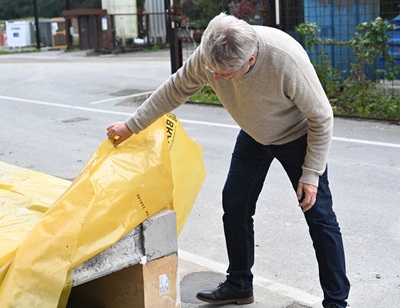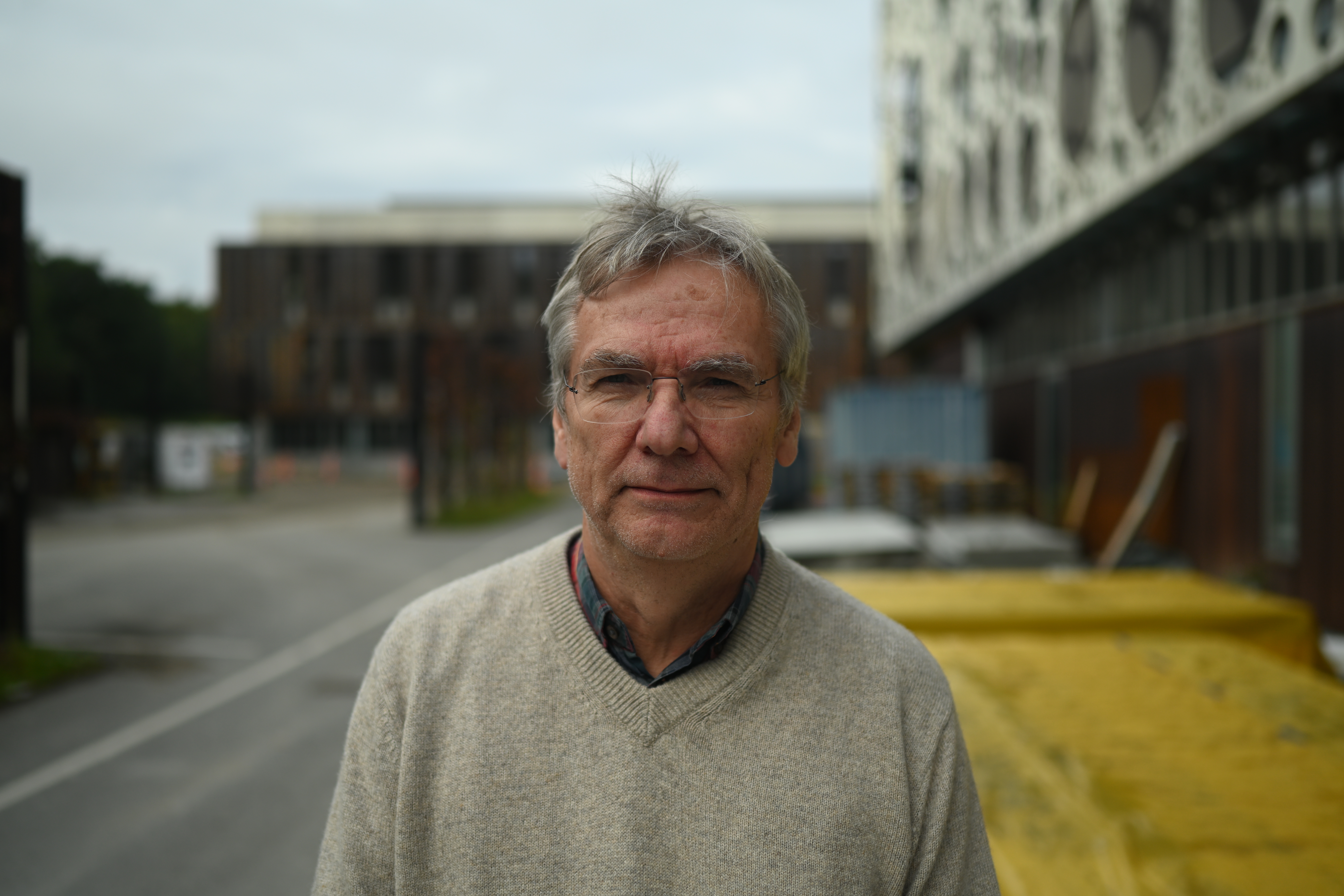University of Southern Denmark's hub for Green Civil Engineering
Green Civil Engineering
University of Southern Denmark has gathered a number of competences and research environments in a hub for Green Civil Engineering
Since the Paris Agreement, there has been an ever-increasing focus on society being able to provide the technological solutions that can deal with climate change. One of our evolving research fields is looking into how we can use existing materials in new combinations, such as combining recycled concrete beams from older buildings with wood beams and using these in new buildings.
At the same time, our understanding and knowledge of sustainability and climate is developing at an increasingly rapid pace. The built environment and the associated technological solutions are an important part of climate change mitigation. From a focus on energy, there is today an increasing focus on circular and biodiverse solutions. In the future, there will be more focus on the operation of buildings, extended life of buildings and construction work and ultimately on all phases and parts of the life cycle of buildings.
It is predicted that focus of the technological solutions will be both processes and products that must be incorporated in all life cycle phases, which will continue to develop and will increasingly require interdisciplinary methods and solutions.
Research areas
Among others, Green Civil Engineering areas encompass digital aspects of the life cycle of sustainable buildings, life cycle assessment (LCA) in the construction industry and how it is used in connection with circular economic models
Sustainable Building and Civil Engineering
The emerging climate challenge requires fundamentally new and research based answers.
How can we realize sustainable buildings at affordable costs?
How can new building activity be supporting a degrowth scenario?
How can we extend the lifetime of building materials and buildings in a circular building perspective?
And how can we better understand the intersections between single built entities and agglomerations of building and infrastructure in form of constructing resilience?
Sustainable Building and Civil Engineering delivers research and innovation within both engineering and architectural disciplines – such as facades – but also conceptualizing how the integration of disciplines can be carried out. The group is inspired by Arups Total Design approach, but also the Danish house builder tradition.
Structural Engineering
 The research area is characterised by a focus on developing design models and assessment methods that can be used in practice. This approach requires experimental and theoretical research in tandem, where models are evaluated and confirmed through physical testing.
The research area is characterised by a focus on developing design models and assessment methods that can be used in practice. This approach requires experimental and theoretical research in tandem, where models are evaluated and confirmed through physical testing.
The group is internationally recognised for its work on developing plasticity theory, and is active in the following domains of concrete structures: behaviour and design methods for structural concrete, design of innovative structures, shear in structural concrete, shear in prestressed beams, design and strength of connections, serviceability design of connections, strengthening of existing structures, and residual load-bearing capacity of damaged existing structures.
The experimental research is conducted in the structural laboratory, which is equipped with state-of-the-art equipment for concrete structures.
Computational Design for Sustainable Architectural Engineering
The built environment plays a vital role in global environmental, social, and economic challenges but suffers from historically low productivity levels and digitalisation. Urgent climate change demands a radical rethink of the architecture, engineering, and construction (AEC) sector as a driver of sustainable innovation and growth. SDU CREATE pioneers this change, integrating cutting-edge computational tools like AI and performance simulation for resource-efficient, carbon-neutral, circular building design and engineering. Our efforts include:
- Developing computational workflows for performance-driven design and ad-hoc form-finding techniques for various material systems such as concrete, wood, and bio-polymers
- Designing high-material efficiency/low-environmental footprint building systems using the latest computational techniques and machine learning, advanced in architectural geometry and bio-inspired strategies
- Integrating architectural design and engineering tasks in seamless computational workflows from design to construction, enhancing design freedom while automating engineering
Architectural Robotics and Digital Construction
Construction robotics is a key driver for achieving a sustainable built environment. SDU CREATE's advanced laboratories are dedicated to experimental applications of architectural robotics and digital fabrication. We are committed to reshaping the construction process through innovative fabrication methods and material processes, aiming to create highly efficient architectural solutions. Our approach involves reshaping the design-build process using cutting-edge robot and sensing technology and prototyping the built environment of the future. Key initiatives include:
- Large-scale 3D printing for building structures and architectural systems with various materials to reduce embodied carbon and enhance design freedom
- Robotic fabrication of bespoke building components employing high-precision robotic machining
- Autonomous assembly and disassembly of timber structures to enhance material circularity
- Collaborative human-robot operations through mixed reality for adaptive construction processes, enabling shared design and building spaces
- Zero-waste material processes through digital fabrication, focusing on repurposing reclaimed elements and innovative uses of production by-products and post-consumer material
Organic photovoltaics for sustainable buildings
The green transition requires massive installation of photovoltaics (PV) to support the electrification of our energy sector and reduce CO2 emissions. SDU CAPE develop colourful, flexible, lightweight and transparent organic photovoltaic cells and modules, and work on their scaled-up manufacturing and integration into various prototypes.
Such colour-tuned and transparent BIPV possess a huge untapped potential in the harvesting of solar energy, where it readily can be embedded in building applications worldwide, e.g. in windows and façade envelopes, to significantly reduce CO2 emissions and support the needed development of nearly zero-energy buildings
Large Structure Production
Robotization and digitalization have been successfully and widely implemented in other industries to heighten productivity, competitiveness, and product quality. However, due to their size, weight, and complexity, it has been difficult to effectively implement automated solutions in the production of large structures as they occur in the sectors construction., maritime and energy.
The sectors still have huge amounts of manual work in their production and at the same time experience a dramatic lack of workforce and fierce global competition. With LSP, we a closely cooperating with industrial partners to develop new robotic system and services for their production challenges as well as by upskilling workers and apprentices on the topics of robotics and AI.
Life Cycle Analysis (LCA)
Life Cycle Analysis (LCA) in the construction industry and how it is used in connection with circular economic models.
Creating a sustainable future requires a holistic insight and understanding of the long-term interactions of technologies and systems with the world on a global scale
Smart Buildings
Development of innovative, sustainable, and occupant-centered building solutions that effectively manage energy resources, reduce environmental impact, and support the transition towards a low-carbon, high-performance built environment
Additive Manufacturing
Investigate different ways of how to fabricate custom design structures such as lattices for tailored mechanical properties. Production of components in both metal and polymer materials, including combinations of those - including expert knowledge in sensor integration into 3D printed components
Sustainable Building and Civil Engineering
Structural Engineering
Computational Design for Sustainable Architectural Engineering
Architectural Robotics and Digital Construction
Organic photovoltaics for sustainable buildings
Large Structure Production
Life Cycle Assessment (LCA)
Smart Buildings
- SDU Center for Energy Informatics
- Smart Buildings
- DanRETwin
- ADRENALIN
- Twin4Build
- CELSIUS
- Danish participation in IEA EBC Annex 81 - Data-Driven Smart Buildings
- BuildCOM
- Control of cooling house
- Danish participation in IEA EBC Annex 67 - Energy Flexible Buildings
- Power Monitor
- COORDICY
- IoTStyring
- Demand-Response Capacity Management in Commercial Buildings
Additive Manufacturing
Last Updated 27.07.2024
